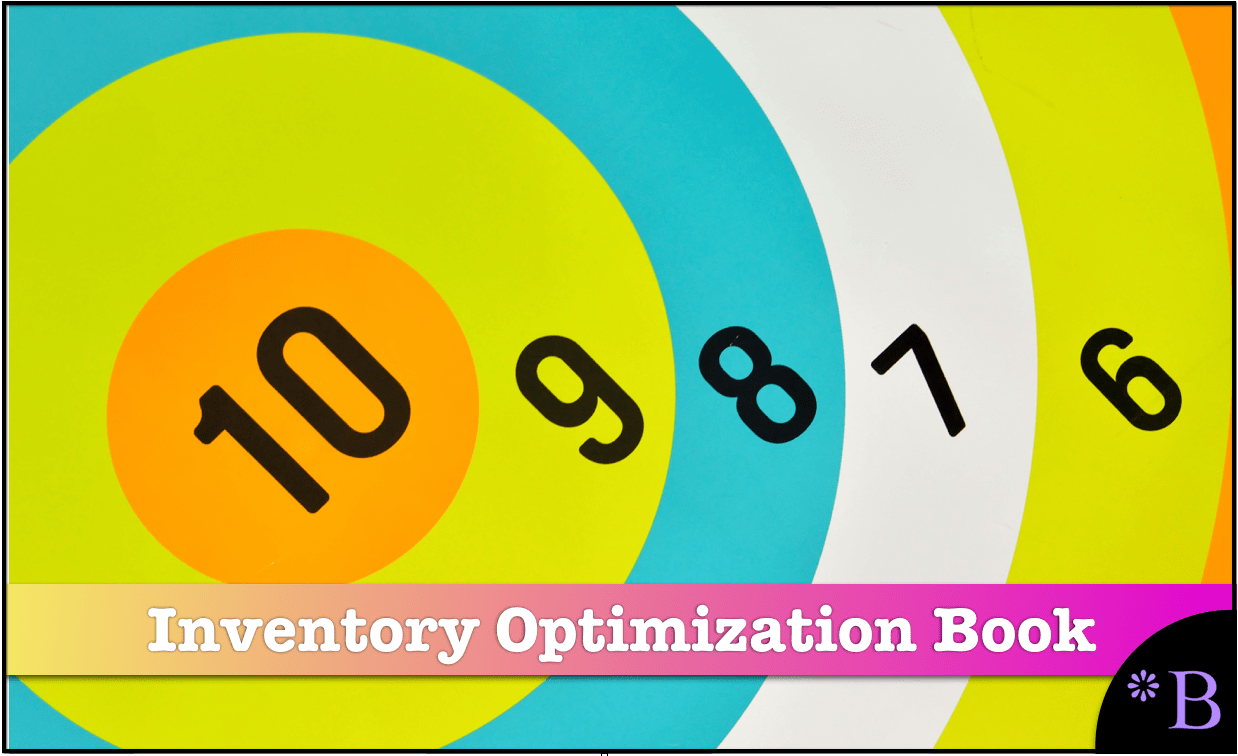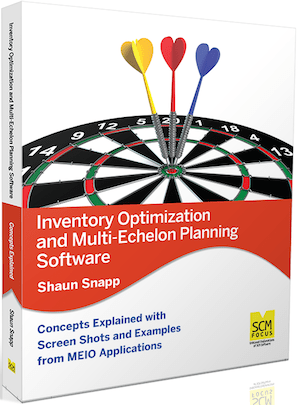
Inventory Optimization and Multi-Echelon Planning Software
Screenshots and examples from MCA Solutions/Servigistics, ToolsGroup, Logility, and SmartOps.
What The Book Covers
This book explains the emerging technology of inventory optimization and multi-echelon (MEIO) supply planning. It takes a complex subject and effectively communicates what MEIO is about in plain English terms. This is the only book currently available that describes MEIO for practitioners, instead of for mathematicians or academics.
The book describes with text and graphics how inventory optimization allows the entire supply plan to be controlled with service levels, and how multi-echelon technology answers the question of where to locate inventory in the supply network. This is the only book on inventory optimization and multi-echelon planning, which compares how different best of breed vendors apply MEIO technology to their products. It also explains why this technology is so vital for supply planning and why companies should be actively investigating this method. The book moves smoothly between concepts to screenshots and descriptions of how the screens are configured and used. This provides the reader with some of the most intriguing areas of functionality within a variety of applications.
Areas of Focus
- Detailed explanations of the twin technologies of inventory optimization and multi-echelon planning.
- The importance of having optimization customized for a supply chain domain.
- The concept of effective lead time and why it is so crucial to understanding multi-echelon planning.
- How inventory optimization compares to cost optimization.
- How MEIO’s assumptions are different from all other supply planning methods and what this means for its capabilities.
- MEIO and simulation.
- How MEIO processes the supply network.
- How MEIO can be used to firmly tie sales to operations in the estimation of pricing for new business.
- The pros and cons of setting service levels in different areas in the application.
A Book Based in Reality
The book provides many examples from real-life project experiences, the emphasis being on the reality of MEIO projects.
Interconnected to Web Information
In order the keep the book at a manageable and easily readable length, the book also provides numerous links out to the Brightwork Research & Analysis site, where supporting articles allow readers to get into more detail on topics that interest them.
Buy Now
Chapters
- Chapter 1: Introduction
- Chapter 2: Where Inventory Optimization and Multi-echelon Planning Fit into the Supply Chain Planning Footprint
- Chapter 3: Inventory Optimization Explained
- Chapter 4: Multi-echelon Planning Explained
- Chapter 5: How Inventory Optimization and Multi-echelon Work Together to Optimize the Supply Plan
- Chapter 6: MEIO versus Cost Optimization
- Chapter 7: MEIO and Simulation
- Chapter 8: MEIO and Service Level Agreements
- Chapter 9: How MEIO Is Different from APS and MRP/DRP
- Chapter 10: Conclusion
Chapter 1: Introduction
- Background and Motivation
- The Necessity of Good Information to Support Good Decisions
- The Importance of Software Screenshots and Vendor Diversity
- How Writing Bias is controlled at Brightwork Research & Analysis an Brightwork Research & Analysis Press
- Why Are There So Few Books on MEIO?
- The Brightwork Research & Analysis Site
- Who Is This Book For?
- Abbreviations
Chapter 2: Where Inventory Optimization and Multi-echelon Planning Fit within the Supply Chain Planning Footprint
- Introduction
- What MEIO Applications Cover
- Understanding the Use of the Forecast with MEIO
- Optimization Customization
- Why Learn about MEIO?
- What Companies Stand to Gain the Most From MEIO?
- What is the State of MEIO Applications?
- The MEIO Data Flow
- Conclusion
Chapter 3: Inventory Optimization Explained
- Background
- Definition of Inventory Optimization
- General Optimizers Solvers versus Enterprise Optimization Solutions
- Examples of General Optimization Solvers
- Dynamic Safety Stock
- What It Means When One Says That “Safety Stock is Optimized”
- Safety Stock and Facility Capacity
- Understanding the General Relationship between Service Level and Inventory
- Control Over Service Levels
- Safety Stock or Target Stocking Level Optimization?
- Segmentation or Inventory Optimization?
- Viewing Segmentation Software as Distinct from MEIO Software
- Conclusion
Chapter 4: Multi-echelon Planning Explained
- Background
- The Questions that Each Term Answers
- Multi-echelon Planning Defined
- A Multi-echelon Network Explained
- Example of a Multi-echelon Network
- MEIO’s Value Adds to the Planning Process
- Taking Dr. Lee’s Multi-echelon Test
- Understanding Effective Lead-time
- The Problems in Automotive Service Supply Chains
- A Better Design
- Where Is the Service Level Being Set?
- Setting Service Levels at the Location
- Pros
- Cons
- Setting Service Levels at the Product-Location Combination
- Pros
- Cons
- Setting Service Levels at the Group Location
- Pros
- Cons
- Setting Service Levels at the Customer
- Pros
- Cons
- Setting Service Levels at a Product Mix
- Pros
- Cons
- Setting Service Levels at the Contract
- Pros
- Cons
- The Mistaken Assumption about Service Levels at the Location
- Considering Who Is the Ultimate Consumer of Service Level
- Making Service Level Changes
- The Issue of a Strong versus a Weak Linkage Between Service Levels and Inventory Levels
- Target Days of Supply
- Supply Chain Precision as a Discussion Point
- Conclusion
Chapter 5: How Inventory Optimization and Multi-echelon Work Together to Optimize the Supply Plan
- What Questions Are Being Answered with MEIO?
- How MEIO Works
- Supply Network Observations
- Effective Lead Time Observations
- Understanding the Sample Model
- Differing Calculation Details
- Aspects of the Sample Model Reflected in the Eventual Stocking Positions
- Redeployment
- Planned Procurement or Production Orders?
- Peeking Below the Hood of MEIO
- Transaction Recommendation Generating Applications vs. Master Data Update MEIO Applications
- Ranking the Recommendations Based on Impact
- Insight into the Ranking
- Getting Alerts Right
- Exception-based Management Planning
- Conclusion
Chapter 6: MEIO versus Cost Optimization
- How Inventory Optimization Differs from Cost Optimization
- Cost Optimization versus MEIO in Implementation
- The Importance of Understanding Cost Optimization
- What is Cost Optimization?
- How Cost Optimization Works
- The Understanding and General Availability of Supply Chain Costs
- The Common Problems of Cost Optimization
- Constraint-based Planning
- Multi-Sourcing in Cost Optimization versus MEIO
- Will the Same Thing that Happened to Cost Optimization Happen to MEIO?
- Cost Minimization, Service Level Control, and Common Supply Planning Objectives
- Service Level Setting and the Service Level Hierarchy
- Conclusion
Chapter 7: MEIO and Simulation
- What is Simulation?
- The Heart of Supply Chain Simulation
- Why MEIO Applications Are Generally Good at Simulation
- How Supply Planning Applications Are Enabled for Simulation from a Data Perspective
- Combining Segments of Different Schemas
- The Importance of Precision of Control in Simulation
- The Ability to Simulate New Business and S&OP
- Interface Aspects that Support Simulation
- Service Level and Inventory Investment Settings
- Accuracy of Simulation Provided by MEIO Applications
- Initial versus Post Go-Live Simulation
- Strategic versus Online Simulations
- Conclusion
Chapter 8: MEIO and Service Level Agreements
- Background
- The History of SLAs
- Standard Limitations in Supply Network Control
- SLAs and MEIO
- Service Level Agreement Configuration
- Reducing Friction between the Sales Organization and Supply Chain
- MEIO for SLA Pricing
- How the Shared Sales/Supply Chain MEIO Instance Works
- Providing a Menu of Options to Customers
- Conclusion
Chapter 9: How MEIO is Different from APS and MRP/DRP
- Background
- Different Assumptions
- The Location Independent Assumption
- The Sequential Processing of the Supply Network
- Decomposition in Cost Optimization
- Decomposition Example: Product: ABC
- How MEIO Differs in Terms of Sequential Processing
- How MEIO Compares Graphically to the Other Supply Planning Methods
- Elaboration on Solution Sophistication Versus Difficulty of Implementation
- How MEIO Compares to the Other Supply Planning Methods Concerning Long Term Maintenance
- System Maintenance
- Operational Maintenance
- Conclusion
Chapter 10: Conclusion
- Objective
- Cost and Benefits Estimation of MEIO
- Assumptions
- The Forces Resisting MEIO
- The Opportunity

Buy Now
Questions about the Book?
Do you have any questions about the book? If so, please leave us a comment in the message box to the right, and we will address them.